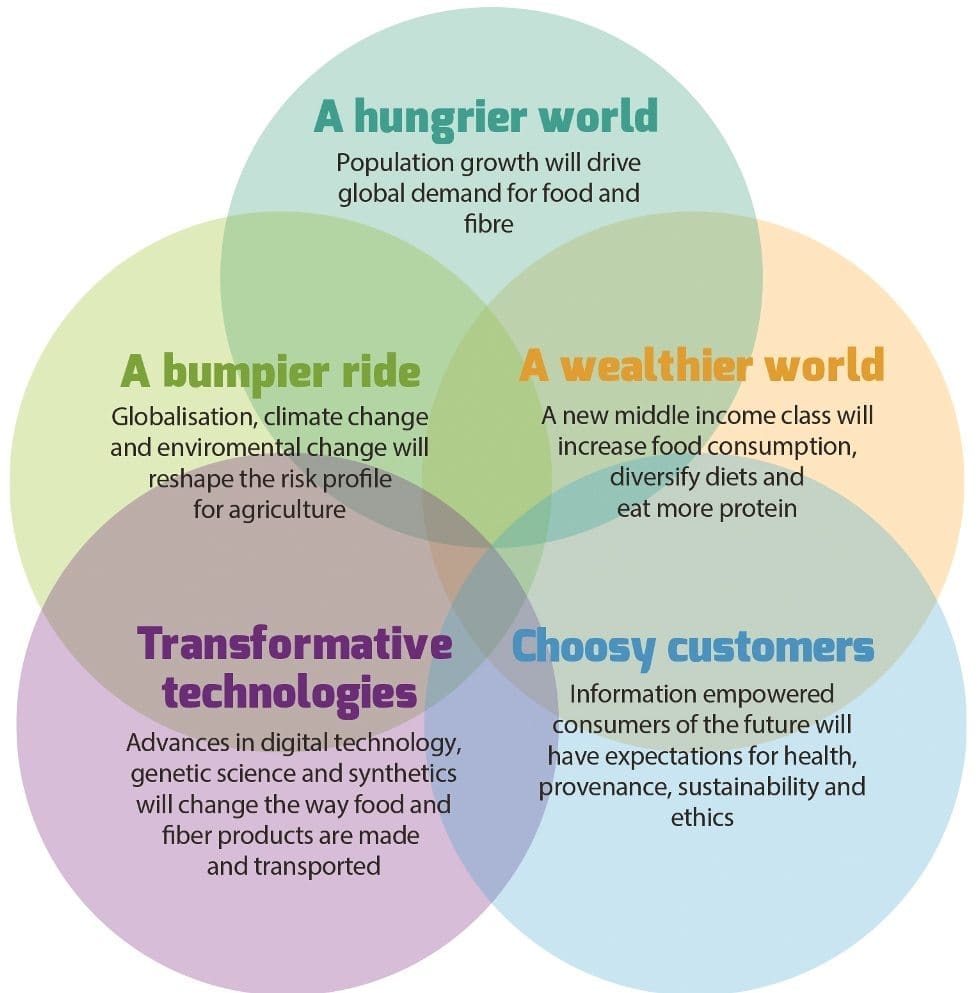NEW research has identified a series of ‘global mega-trends’ that represent opportunities for Australian agriculture as the world grows hungrier, yet wealthier, with fussier consumers by the year 2035.
The project, jointly backed by the Rural Industries Research and Development Corporation and CSIRO highlights five key megatrends that will significantly impact the future of Australian agriculture in the next 15 to 20 years.
These megatrends are:
- A hungrier world: By 2050, there will be 70 percent or 2.3 billion more people on earth, who will need 60 to 70 percent more food than what’s currently available.
- A wealthier world: Increasingly wealthy consumers in developing economies will drive demand for more and diverse foods. In Asia alone, with more than one billion people are expected to move out of poverty as average incomes rise from US$12,000 to US$44,000 per person by 2060. Beef consumption is predicted to rise 120pc, while dairy consumption will double by 2050.
- Fussier customers: Empowered by information, the consumers of 2050 are likely to expect food to be nothing less than healthy, nutritional, clean, green and ethically produced.
- Transformative technologies: Advanced digital, genetic and materials science technologies will enable farmers and graziers to improve how they produce food and fibre products, while innovative sensory systems and data analytics will create highly integrated ‘farm to fork’ supply chains. Producers will be able to make better decisions and manage risk more effectively, while consumers will have greater access to trace the origins of their food, putting production methods under the spotlight.
- A bumpier ride: Australian rural industries can expect a changed risk profile, which will call for new and deeper levels of resilience to withstand shocks associated with climate change, environmental change and globalisation.
Through its National Rural Issues program, RIRDC, in partnership with CSIRO, undertook the ‘big-picture’ research to help Australia’s agricultural sector anticipate and pro-actively plan for change. The project details the implications, opportunities and challenges for Australian farmers under the Mega- trends scenario.
“Research of this scale and foresight is critical to ensuring Australia’s agricultural sector maintains and grows its vibrancy, sustainability and competitiveness,” said RIRDC’s managing director, Craig Burns.
“While the projected increases in global demand for food could be perceived as an insurmountable challenge, our farmers, who supply 93pc of our domestic food needs and are highly export-oriented, are renowned for their capacity to adapt, innovate, achieve productivity gains despite declining terms of trade, and respond strongly to risks.”
“They are well-placed to address and capitalise on these megatrends,” he said.
The research reinforced the message that the predicted wealthier and choosier Asian consumer of 2035 represent a key opportunity for Australian farmers to drive new markets in that region, underpinned by the need for ongoing research and development to ensure future farming systems improve productivity.
“However we need to be smart and be on the front foot as we are not the only one with our eyes on these opportunities,” Mr Burns said.
Principal scientist in strategy and foresight at CSIRO, Stefan Hajkowicz, who co-led the research, said the megatrends insights pointed to a bright future for Australian agriculture.
“Overall conditions are set for strong demand growth in food and fibre products across Asia along with opportunities for diversification as diets within the region become increasingly westernised,” he said.
“The ‘Where did my food come from?’ factor will be a big deal for future food consumers. Establishing provenance, quality and safety will allow Australian producers to fetch market premiums. And, there’s nothing low-tech about Australian agriculture. It is high-tech and well-placed to go super-high-tech.”
How can Australian agriculture become more competitive?
Complementing the megatrends insights, another area of research released recently considers new tools to measure and influence Australian farm competitiveness in the global marketplace.
Undertaken by the Australian Farm Institute, this research investigated the potential for the development of a competitiveness indicator or index as a decision-making tool to enhance agricultural competitiveness.
While the research highlighted a number of limitations in developing such an index, including the lack of robust, internationally-comparable agriculture sector statistical data, it found that a ‘dashboard’ of indicators of national agricultural competitiveness could be achievable.
“A case study using the dashboard to compare the agricultural competitiveness of Australia and the US illustrated that this tool provides a more useful approach, but only to the extent of providing a starting point for further analysis,” AFI’s executive director Mick Keogh said.
“To progress this, the quality, consistency and availability of national and international agriculture sector data needs to improve,” he said.
- The global Mega-Trend report can be accessed here.
- The Competitiveness of Australian Agriculture Indicator Report can be accessed here.
Source: RIRDC


Excellent summation Jon on the future tends in agriculture worldwide and here in Australia.
Can we remain competitive?
We have to be up to date with information
and data!!!
Our True Aussie Brand is most important to our success in the future.
What makes our products and produce desirable must continue.